Posts Tagged ‘CW’
 1929 BK QSO Party Fun
1929 BK QSO Party Fun
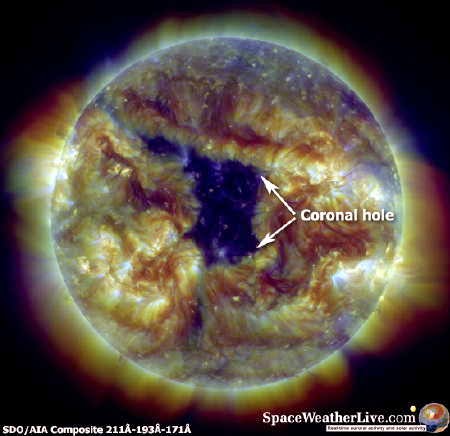 |
| Courtesy: http://www.spaceweatherlive.com |
Not to disappoint, the usual BK winds came up, right on schedule as well, almost coincidental with the start of the Party. Thankfully, weekend number two saw no wind whatsoever....a rare event in December....but, from the sound of many other notes, I wasn't the only one having windy weather.
DE6 2317 40 N1BUG 568 449 TNT 29 10 PAUL ME
DE6 2322 40 WA1JAS 569 559 HART 29 8 MIKE ME
DE6 2347 40 W7LNG 567 578 TNT 29 6 BUD OR
DE6 2352 40 VE7BDQ 599 599 COLP 29 10 JOHN BC
DE7 0014 40 K7SF 578 579 TNT 29 10 STEVE OR
DE7 0105 40 NE1S 449 449 TNT 29 9 LARRY ME
DE7 0120 40 WB2AWQ 579 569 HART 29 10 HOWIE NV
DE7 0133 40 K4JYS 449 449 TNT 29 10 BILL NC
DE7 0145 40 WB8APR 559 449 MOPA 29 5 JOHN MI
DE12 2257 40 K0KP 579 559 HART 29 9 REX MN
DE6 0202 80 AB0CW 559 549 HART 29 5 MARK CO
DE6 0317 80 KK7UV 599 599 HART 28 9 STEVE MT
DE6 0329 80 KE0Z 559 559 HART 29 8 WILL SD
DE6 0356 80 N1BUG 449 559 TNT 29 10 PAUL ME
DE6 0403 80 KC9WYV 579 539 MOPA 29 9 JOE MN
DE6 0415 80 VE7BDQ 599 599 COLP 29 10 JOHN BC
DE6 0422 80 AA2YV 439 449 HART 29 10 BILL NY
DE6 0438 80 N8YE 559 569 TPTG 25 9 STEVE OH
DE6 0442 80 W7LNG 578 588 TNT 29 9 BUD OR
DE6 0524 80 K0KP 599 589 HART 29 9 REX MN
DE6 0530 80 W2ICE/0 579 339 COLP 29 10 SCOTT MN
DE6 0539 80 VE3AWA 578 339 TNT 29 10 LOU ON
DE6 0548 80 KI0DB 559 579 MOPA 29 10 MARK MN
DE6 1229 80 W0LGU 559 559 MOPA 29 9 TOM MN
DE6 1240 80 K0KCY 559 449 MOPA 29 10 TONY MN
DE12 0352 80 KB0ROB 569 569 MOPA 29 9 HAROLD MN
DE12 0427 80 W8KGI 559 448 MOPA 29 10 JIM NM
DE12 0440 80 W0VLZ 559 339 TNT 29 10 NIEL MN
DE12 0509 80 K4JYS 559 559 HART 29 15 BILL NC
DE12 0512 80 WB9WHG 569 449 MOPA 29 20 DAVE WI
DE12 0524 80 W0LS 599 579 HART 29 9 HARRY MN
DE12 0401 160 KK7UV 579 559 HART 28 10 STEVE MT
DE12 0539 160 VE7BDQ 599 599 COLP 29 10 JOHN BC
DE12 0542 160 W0LS 559 559 HART 29 9 HARRY
More information on '29 building may be found here in previous "'29-style blogs" and good project discussions always abound at the Yahoo "AWA Group" builder's site.
It's really not too early to start building for next year's BK!
 Loop..Perseus..and CLE188
Loop..Perseus..and CLE188
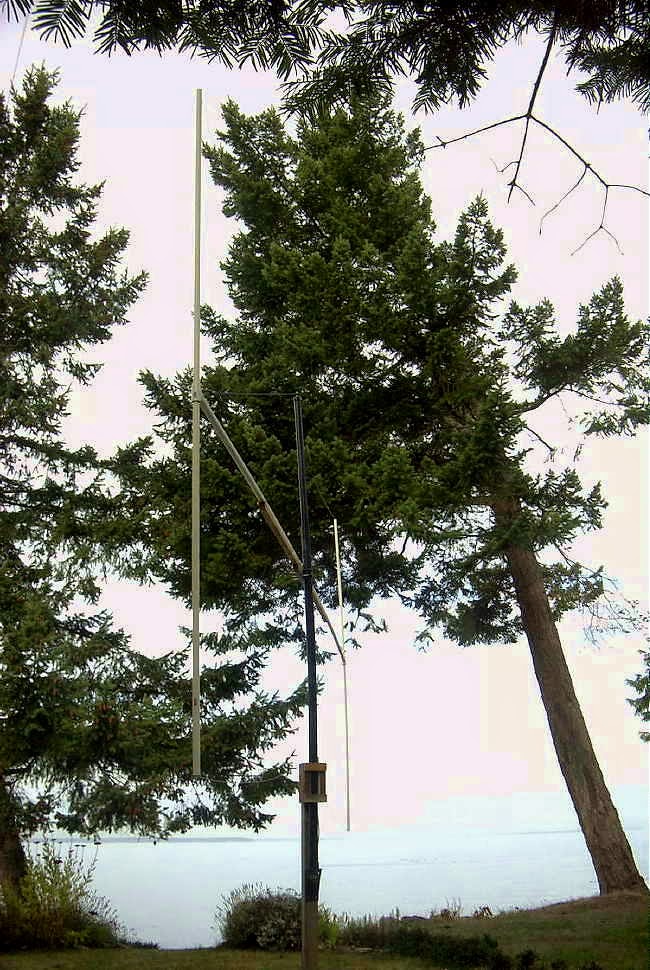 |
| 10' x 20' LF Loop |
As is usually the case, conditions deteriorated rapidly as the CLE weekend approached. Conditions varied throughout North America as those listening from the south-eastern regions of the U.S. reported much better propagation than those further to the northwest. Friday night appeared to be the best of the lot but all three nights were very much less than stellar.
The three-night event produced a total of 39 NDBs, with a couple of surprises.
DD UTC kHz Call mi Location
----------------------------------------------------------
22 05:00 370 YBV 1169 Berens River Apt, MB, CAN
22 06:59 370 OUN 1611 UoOk Westheimer Apt, OK, USA
22 05:00 371 YK 211 Yakima, WA, USA
23 09:00 371 PUR 1629 Marshall, MO, USA
22 05:00 371 ITU 558 Great Falls, MT, USA
22 05:00 371 GW 1946 Kuujjuarapik, QC, CAN
22 05:00 372 ZPA 824 Prince Albert, SK, CAN
22 05:00 372 YCO 1340 Coppermine, NU, CAN
22 05:12 372 FPN 675 Petersburg, ALS
22 07:00 373 TF 1191 Pueblo Mem Apt, CO, USA
22 05:00 373 MF 444 Table Rock, OR, USA
22 05:00 374 LV 776 Livermore, CA, USA
22 05:00 374 EX 190 Kelowna, BC, CAN
23 09:00 374 EE 1319 Forada, MN, USA
22 05:00 374 BOD 942 Bowman, ND, USA
24 09:59 375 PSN 1854 Palestine, TX, USA
22 05:00 375 FS 896 Fort Simpson, NT, CAN
22 10:59 375 DW 1629 Owasso, OK, USA
22 07:00 375 CP 900 Casper, WY, USA
22 05:00 375 BD 803 Moose Jaw, SK, CAN
22 07:00 376 ZIN 3326 Matthew Town, BAH
22 07:00 376 YAG 1345 Fort Frances, ON, CAN
22 13:59 376 PVQ 1690 Deadhorse, ALS
22 06:59 377 EHA 1350 Elkhart, KS, USA
23 06:59 378 ZFA 1000 Faro Municipal Apt, YT, CAN
22 05:00 378 OT 381 North Bend, OR, USA
22 10:59 379 ZEG 526 Edmonton Intl, AB, CAN
22 05:00 379 YBE 945 Uranium City, SK, CAN
23 12:59 379 IWW 1360 Kenai, ALS
22 09:00 380 OEL 1297 Oakley, KS, USA
22 05:00 380 GC 899 Gillette, WY, USA
22 05:00 382 YPW 86 Powell River, BC, CAN
22 05:00 382 YE 686 Fort Nelson, BC, CAN
22 12:59 382 JNR 1731 Unalakleet, ALS
22 12:00 382 GRN 1522 Guerro Negro, MEX
22 05:00 382 AW 75 Marysville, WA, USA
22 06:59 383 PI 658 Pocatello, ID, USA
22 05:20 383 CNP 1146 Chappell, NE, USA
22 05:00 384 3F 792 Ile-a-la-crosse, SK, CAN
-----------------------------------------------------------------
This particular frequency range (370-384.9kHz) is a tough one for me, since my local pest signal, 'AP' is on 378kHz, smack in the middle of the listening range. 'AP's antenna is just .4 miles (2100') from my antenna and its signal is about 60db over S9.... Very loud!
 |
| AP to me...Courtesy: https://www.google.ca/maps/ |
Using this 'deep null' position, I was (somewhat surprisingly) able to log another Canadian NDB (ZFA Mayo Airprt, Yukon Territory) on the same frequency as AP. The ident-tone modulation frequencies are separated by 10Hz (408Hz vs 418Hz) which was enough to allow the very narrow ~3Hz Perseus filtering, combined with two notch filters, to reveal the 'ZFA' identifier between the 'AP' identifier. Listen for the weak 'ZFA' ident after the loud keying artifacts of 'AP', when they are transmitting just a steady tone.
The other surprise was the logging of 'PVQ' in Deadhorse, Alaska, way up on the extreme northern slope oil fields.
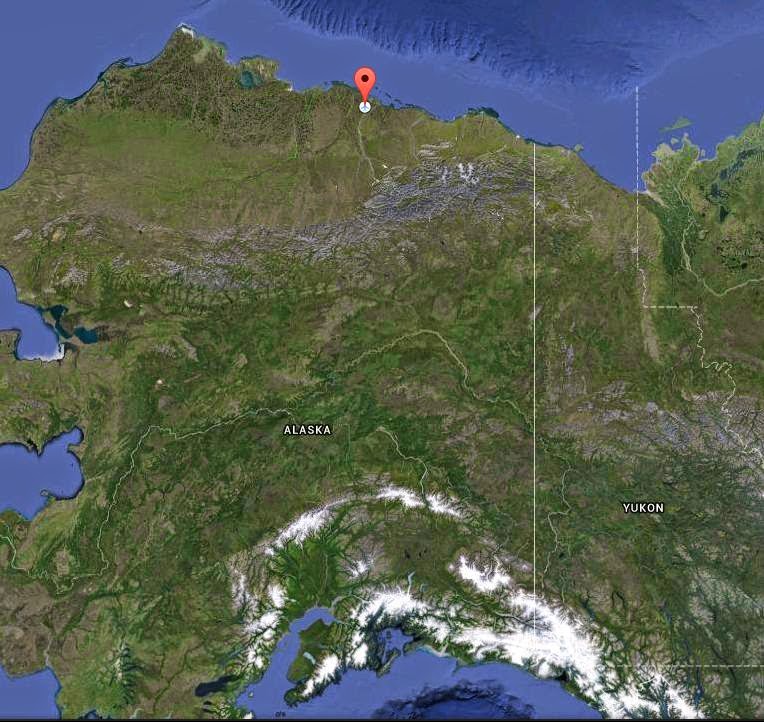 |
| Courtesy: https://www.google.ca/maps/ |
CLE organizer, Brian Keyte (G3SIA), reports 51 participants worldwide and over 2100 reception reports. All reports have been added to the RNA/REU beacon database.
As well, Brian will be publishing all results on the NDB Information page shortly.
All-in-all CLE188 was another enjoyable event....hopefully conditions will be better by this time next month and if you did not participate, maybe you will give it a try next time!
 More BK Building
More BK Building
 |
| 1935 ARRL Handbook. Source: http://www.arrl.org/ |
Although John did not have every period-appropriate component available to him, it didn't discourage him from building his BK rig. For too many, this is often a stumbling block that leads to nothing being built....as the boy's of '29 no doubt would have done, he put something together completely from his junkbox.
It will be super to have another left-coast station in this years '29 Party...and a Canadian station to boot!
Anyone else building for the BK? ....there's still a few weeks left.
 BK Building…
BK Building…
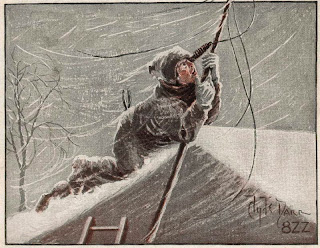 |
| March 1926 QST. Courtesy: ARRL |
Every year as contest time approaches, I anxiously follow our local weather patterns in hope that the winds remain quiet for the event. For the past few years, the wind has been non-existent...right until zero-hour, when, almost as if a switch were thrown, the wind ramps up to gale-like conditions. Now if you've never heard a self-excited oscillator directly connected to a wind-blown antenna, then be sure to take a listen to this year's BK. These '29 rigs are often not very pretty-sounding, even into a dummy load, but couple them to the wind and things get very 'nostalgic-sounding' quickly. Frequency shifts in the order of several hundred Hertz between letters are not uncommon, making copying a weak signal difficult and almost impossible if listening with a narrow filter. The amplifier will effectively isolate the effects of a shifting antenna impedance from the oscillator stage, making life very much less stressful, come BK time.
My plan is to follow the wisdom of the '29ers themselves, carefully explained in "More Power With Better Frequency Stability" by George Grammer and published in the February 1931 edition of QST. I'm always impressed at how quickly those folks back in the 20's figured out so many of the important "basics of radio" that have withstood the test of time. It must have been an exciting time to be a ham! A glance through any of the numerous radio magazines from the late 20's and early 30's reveals a vibrant market for the homebrewer, with every type of component available. Whether the average ham could afford to buy them in the hungry-thirties is another question.
I've chosen to use another type '10' power triode as my amplifier, as shown below.
 |
| Courtesy: ARRL |
I see the main challenges being coupling conveniently from the oscillator as well as neutralizing the triode amplifier...I wonder, will neutralizing it on 40m (for example) also make it stable on 80m?
As well, since the type '10' uses a directly-heated cathode, if I wish to let the oscillator run while I key the amplifier, a separate filament supply will be required for each tube. With this in mind, I've got the ball rolling this week with the construction of a dedicated '29 rig filament supply. The supply uses two center-tapped 5V transformers with their secondaries in series and brought out to the back panel. This will allow me to use tubes with 2.5V, 5V, 7.5V and 10V filaments...up to 3A.
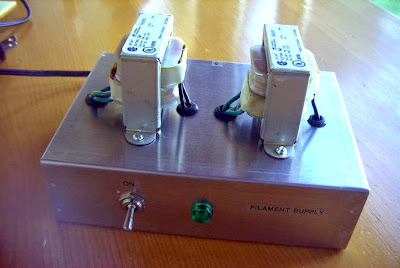 |
| New filament supply |
Are you building or planning anything for this year's BK Party?
 “CQ BR” – The Bug Roundup!
“CQ BR” – The Bug Roundup!
Sponsoring the event is the Samuel F. Morse Amateur Radio Club (W6SFM) of Sacramento, CA. Detailed information may be found at their website, located here.
The club page describes the event as :
"a special time to bring bug operators together on the air. In the same spirit as ARRL's Straight Key Night, participants are encouraged to make simple, conversational, “chewing-the-fat” QSOs using their bug type key. This is an opportunity to exercise, share and exhibit your personalized fist. This is NOT a contest. Call "CQ BR" so folks know you are a Bug Roundup Participant."
You may have guessed by now that I love CW and always have, since learning the 'code' as an eleven-year old in Scouts! Our Scoutmaster had procured several sets of beautiful boxed Aldis signalling lamps, the same as shown below:
 |
| Image Courtesy: http://www.museumoftechnology.org.uk |
Our leader worked in the Marine Building, the tallest building at the time, in downtown Vancouver.
 |
| Marine Building circa 1947. Courtesy: http://searcharchives.vancouver.ca/ |
It nice to see events like this and the ARRL's "Straight Key Night" along with clubs like the, "SKCC" , "FISTS", "FOC" and "The CW Operators' Club", all doing their best to keep CW alive. Hopefully you will have some time to play in the 'BR' this weekend.
 NAQCC Transitions
NAQCC Transitions
Big changes this month at the North American QRP CW Club (NAQCC).
Paul Huff, N8XMS of Livonia, Michigan becomes the new club President. He’s takes the reins from founder Thomas Mitchell, WY3H who recently retired the post. Meanwhile, John Smithson, N8ZYA of Charleston, West Virginia has assumed the Vice President role from the other club founder, John Shannon, K3WWP – who also retired his position.
Launched in 2004, the NAQCC promotes QRP and CW operation through numerous on-air activities. With more than 7,000 world-wide members, the club is very popular and continues to enjoy steady growth. Membership remains free and you can dive as deeply into the action as you care to go, without running out of interesting things to do and goals to achieve.
The monthly club newsletter keeps members informed, educated and entertained and has become one of the premier ham radio club publications available online.
Congratulations to Paul and John as they lead the NAQCC into the next decade of low-power radio fun and adventure!
Filed under: Ham Radio, Syndicate Tagged: club, cw, naqcc, qrp
![]()
 630m Crossband Summary
630m Crossband Summary
Friday evening's 630m crossband activity was 'interesting' in many respects. Propagation, which had been improving slowly, chose to follow Murphy's Law. The K-index, holding at a quiet '1', rose to level '3' by the time our event had concluded, as the geomagnetic activity ramped up. Additionally, lightning pocketed various areas of the continent, making listening noisy for many.
From here on Mayne Island (CN88iu), good two-way CW crossband contacts were made with the stations in the following order:
- N7IO (Seattle, Washington)
- VE7CA (North Vancouver, BC)
- KK7UV (Missoula, Montana)
- NW7E (Bend, Oregon)
- KU7Z (Ogden, Utah)
- VA5LF (Saskatoon, Sakatchewan)
- K7SF (Portland, Oregon)
- VE7BKX (North Vancouver, BC)
- K6TOP (Los Gatos, California)
- ABØCW (Westminster, Colorado)
- NO3M (Saegerton, Pennsylvania)
- KB5NJD (Duncanville, Texas)
- W7MTL (Independence, Oregon)
- KØSBV (Tucson, Arizona)
- WB6DCE (Seaside, California)
- KO6BB (Merced, California)
- K6CLS (Palo Alto, California)
- WY3B (Kaneohe, Hawaii)
- AA7U (La Grande, Oregon)
I was also more than excited to exchange signal reports with Pennsylvania and Texas. Considering conditions, this distance was far beyond my expectation but both of these stations have very efficient, dedicated 630m antenna systems.
John, VE7BDQ, worked the following stations on crossband:
- VE7CA (North Vancouver, BC)
- W7DRA (Seattle, Washington)
- N7IO (Seattle, Washington)
- NW7E (Bend, Oregon)
- KK7UV (Missoula, Montana)
- KU7Z (Ogden, Utah)
- VA7JWS (Delta, BC)
- VA5LF (Saskatoon, Sakatchewan)
- WB6W (Oysterville, Washington)
- K5HK (Reno, Nevada)
- KØSBV (Tucson, Arizona)
- WY3B (Kaneohe, Hawaii)
It was gratifying to see all of these fellows making the effort to listen for our signals or to attempt the QSO.
This exercise taught me a few things about our new band.
- It is not necessary to have huge antennas and acreage to make this band work. Good solid contacts can be easily made with small backyard antenna systems.
- With good systems on both ends, transcontinental QSO's can be made.
- There really should be more interest by Canadian amateurs in their newest band as so much work has been put into securing this portion of the spectrum as a ham band. It was very disappointing not to work any stations in VE6, VE4 or VE3 land.
- There is already much interest in this band by U.S. amateurs, many of them anxiously awaiting the day that they can also call it a ham band.
I would like very much to continue this type of crossband activity to try and generate more interest in our new band. I'm presently considering a weekly, one-night crossband operation, similar to Friday's event, perhaps running for one hour per week. The main difficulty will be in getting the word out to those that might wish to participate.
















